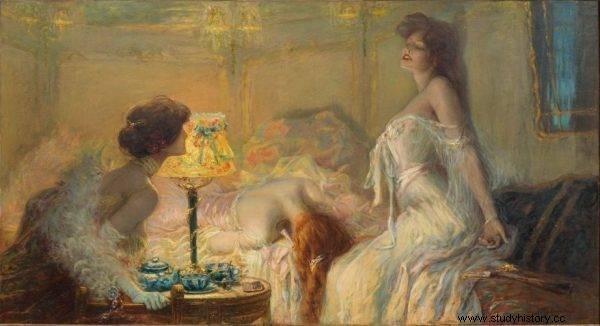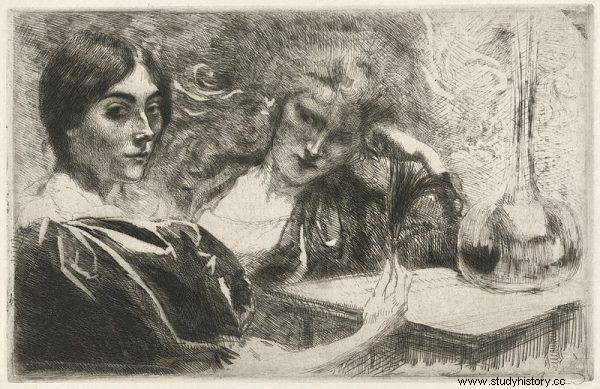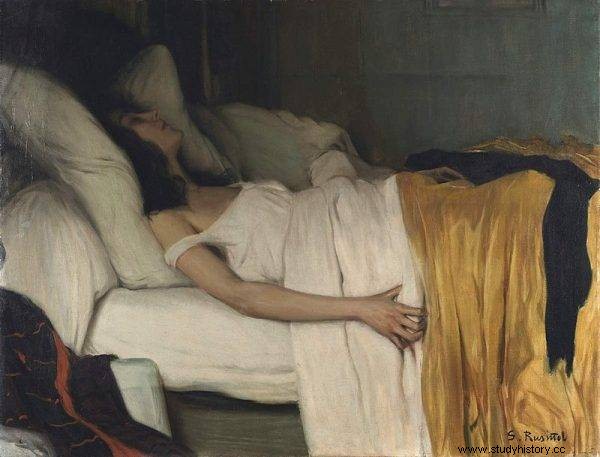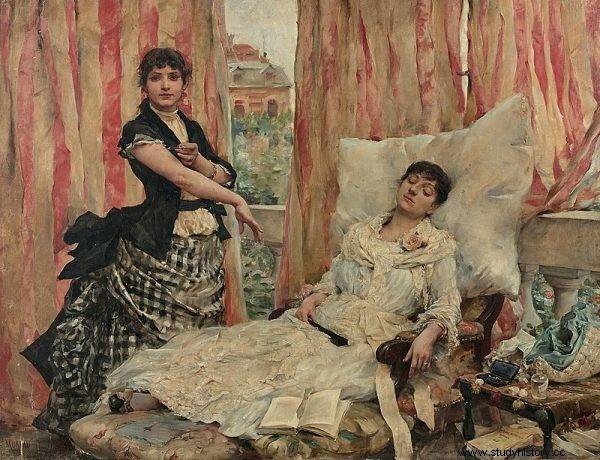It was supposed to be a miracle cure for everything, but in the late nineteenth century it caused a plague of drug addiction. The main victims of morphine addiction were women.
Morphine was long considered a miracle cure for everything. At the beginning of the nineteenth century, medics finally received a measure that provided patients with quick and effective help. Only after some time did the doctors notice that he was very addictive.
Certainly, morphine addiction was not common. Interestingly, this addiction has dominated mainly one social class - the upper class and the aristocracy. Young women from good homes were usually the victims of the drug. Why? To answer this question, you first need to know the history of the substance that morphine is derived from, opium.
Opium is taking over the world
Opium is produced by drying the juice of unripe poppy seeds. This measure has been known to mankind since antiquity. Emperor Marcus Aurelius used to drink the infusion with its addition before going to bed.
In later centuries, thanks to the Arabs, the poppy seeds and the method of opium production made their way to Iran and India, and in the 8th century to China. It was in the Middle Kingdom that opium was first used not only as a medicine, but also as a narcotic substance. In the 17th century, the Chinese began to smoke the so-called madak, a mixture of opium and tobacco. In later years, they found a way to smoke pure opium.

The drug victims were usually young women from good homes.
This custom spread to Europe and North America in the early 18th century. It was not entertainment for everyone. The representatives of a small circle of aristocratic elites and the criminal world (especially the United States) enjoyed drug use. In the early nineteenth century, Europeans and the people of the New World continued to view opium primarily through the prism of its medicinal properties.
The popular alcoholic brew with an admixture of herbs and opium, called laudanum, was known in the Old Continent since the 16th century. Another specificity containing an extract of poppy heads was an ointment called teriak. In 1804 there was another breakthrough in the therapeutic use of opium. It was then that the German pharmacist, Friedrich Sertürner, managed to separate an unusual chemical from it. In part of the Greek god of sleep Morpheus, he was called morphine.
Holy morphine
More than twenty years had to pass before a way to mass-produce morphine was invented. Once that happened, however, the drug quickly gained popularity. Initially, morphine was administered orally. It was soon discovered that a better way was to dissolve it in water and inject it . Part of the medical community admitted that the drug in the form of a tablet may have some addictive properties. However, intramuscular injection was considered safe.
A morphine injection relieved the pain immediately and relieved a whole range of ailments. In addition, he put the patient in a euphoric mood. Both doctors and patients were delighted with the power of the drug. The medics did not even have to inquire about what was really wrong with them. A quick injection of morphine eliminated the need to seek a diagnosis .

A morphine injection relieved the pain immediately and relieved a whole range of ailments. Moreover, he put the patient in a euphoric mood.
Later, when the negative effects of its use were discovered, was contemptuously called morphine "the drug of lazy doctors." By then, hundreds of thousands of people had found out that it could be both a wonder drug and a highly addictive drug.
Known morphinists were, among others:Otto von Bismarck, Juliusz Verne or Friedrich Sertürner himself. Verne was so delighted with her actions that he even wrote a sonnet in her honor:
Oh! Stab me a hundred times with your wonderful needle and I will thank you a hundred times for Saint Morphine. You whom Aesculapius made Goddess.
The growing popularity of morphine was also associated with the wars in the nineteenth century. For doctors treating soldiers in the Civil War or the Crimean War, morphine became the primary medical agent.
Even in the mid-nineteenth century, no one cared much for its addictive properties. But at the end of the century, doctors realized that the problem was really serious. When they started organizing help for addicts, it turned out that for the most part they were ladies of high society and aristocrat.
Only one thing in my mind…
It is estimated that at the end of the 19th century, women accounted for 60 to 70% of patients treated for morphine addiction. This phenomenon was most common in England, Germany, France and the United States.
According to data presented by American doctors, the addiction process usually began between the ages of 25 and 35. The typical morphinist was a middle-class or upper-class woman from a large city . In the USA, there were also wives and relatives of great landowners in the South. The most important factor that led to this situation was relatively easy access to medical care. Lower class representatives could not dream of the luxury of having their own doctors.

The aristocrat, famous for their sensitivity, complaining of neuroses, blues, states of depression, depression and even sleep disorders, were automatically qualified for treatment with morphine.
The aristocrat, famous for its sensitivity, complaining of neuroses, blues, states of depression, depression and even sleep disorders, were automatically qualified for treatment with morphine. It was the same with any problems of a gynecological nature. What additionally contributed to the quick addiction was the habit of leaving the drug to patients at home and the order to inject themselves.
Unattended, the morphinist dosed herself the "panacea" at her discretion. When she additionally managed to find out what agent she was receiving, she could easily buy it from a pharmacist. For a long time, there were no restrictions on purchasing morphine from pharmacies.
To justify doctors, it should be added that they were often subjected to pressure from their wealthy patients and their families. Since morphine was quickly providing the desired relief, why not use it? One of the medics mentioned that when he arrived at his patient, she threw herself at him with a shout:" Oh doctor, stab me quickly ". It was, of course, a morphine injection.
Confessions of a 19th-century morphinist
Doctors' use of morphine was the major route to addiction, but not the only one. For some women, from the very beginning, morphine was not a drug, but a drug. Ladies looking for euphoric sensations used it because it was a means of providing a kind of elitism. Unlike alcohol, not everyone had access to it. Morphine has become its more refined substitute.
Over time, morphine syringes have become as popular as cigarettes . Often, women did not stop hiding their addiction, but flaunted it. The morphine bottles and syringes began to resemble a kind of jewelry. They have been worn by many fashionable ladies.

The morphine bottles and syringes began to resemble a kind of jewelry. They have been worn by many fashionable ladies.
The reasons for fleeing into the world of narcotic visions varied widely. Some of them reacted to their frustrations in this way or took morphine out of boredom or for entertainment. Well-educated women in opiates melted their sorrows about not being able to fulfill their ambitions. We learn how an important element of life could become morphine from a letter from an anonymous lady:
I am the last person in the world who could make excuses, but you really do not know what morphine means to many of us modern women without a profession, without any convictions . Morphine is able to make life more bearable . It adds truth to our dreams (…). I want to say that reality alone is not enough for us. Believe me, each of us has to add some dreams to it. Taking morphine makes life easier.
What could have been a salvation for women's souls became dangerous to their bodies. As a result of taking subsequent injections, my arms became covered with scabs and ulcers. They themselves were increasingly damaged by their addiction ...
New is coming
The phenomenon of morphine addiction began to be mastered at the turn of the 19th and 20th centuries. The awareness of its undesirable effects has increased significantly among doctors. Medics began to be afraid of prescribing it. The development of science and medicine meant that drug stuffing gave way to more reliable diagnosis.
The theory about the bacterial basis of diseases was gaining more and more popularity, aspirin was invented, and Wilhelm Roentgen discovered the existence of X-rays. Morphine will have its little "renaissance" only during World War I. . For injured soldiers, it often became the only pain reliever.
Revealing the negative properties of morphine has become a reason to look for an agent that would be equally effective, but not so addictive. In 1897, the German chemist-pharmacist Felix Hoffman announced success. A scientist working for Bayer has created an agent called diacetylmorphine. He said it would be the perfect cough medicine. When looking for a commercial name for his specificity, he decided that it was from the German heroisch "Baptize" him ... heroin.
Bibliography:
- Courtwright, Dark paradise. A history of opiate addiction in America , Cambridge 2001.
- Courtwright, Forces of habit. Drugs and the making of the modern world , Cambridge 2002.
- Hodgson, In the arms of Morpheus. The tragic history of laudanum, morphine and patent medicines , Vancouver 2001.
